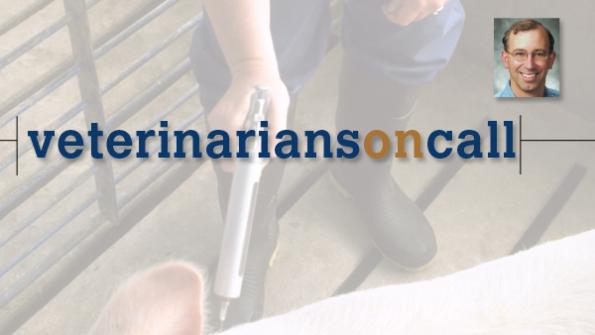November 15, 2012

In the late 1990s, European animal health officials identified a condition in swine that caused a chronic wasting syndrome in nursery pigs. However, not until the mid-2000s did a syndrome become recognized in the United States that included high mortality and morbidity in late nursery to finishing swine. The syndrome was originally coined postweaning multi-systemic wasting syndrome (PMWS). It was thought to be caused by everything from mycotoxins to virus. Later, it was learned the cause was porcine circovirus type 2 (PCV2).
Early on, PCV2 commonly produced 20-40% pig mortality. The pigs that survived performed very well despite the lack of commercial vaccines. Many approaches attempted to reduce the severe effects of the virus. Once vaccine became available, rationing of product from manufacturers led farms to stretch supply.
Today, there is ample supply of four commercial vaccines for control of PCV2. These vaccines all have different labels for use. There are one-dose, two-dose, and one- or two-dose programs. Some PCV2 vaccines also come in combination with Mycoplasma pneumonia.
In general, PCV2 vaccination is given to replacement gilts and piglets. Replacement gilts are vaccinated at selection or prior to entering the sow herd to stabilize their immunity. The industry has settled on the vaccination of piglets at approximately 3 weeks of age for the one-dose product and the first dose of two-dose products. Two-dose products are then boostered three weeks after the initial dose is administered.
Few farms have never vaccinated or stopped vaccinating for PCV2 once they started. It is such a devastating disease that few have been brave enough to try groups without vaccine. The very first group experiment can fall apart.
More farms have started to vaccinate mature sows. When PCV2 originally went through the industry, natural immunity was high in the sow herds. Sow herds today likely have varying levels of immunity. Blood samples are virtually always positive for PCV2 in mature swine, so serology is not of much value. The off-label use of vaccines in mature sows, prescribed by your veterinarian, is used to equalize immunity in the sow herd.
Case Study No. 1
One of our early cases of PCV2 involved a 1,500-sow, multiple-site farm with sows on one site and a nursery and finishers on another. The nursery was hotel style with seven weeks of production rotating through the rooms. Pigs were weaned at an average age of 18 days.
Respiratory signs and 30% mortality occurred at about five weeks into the nursery. Postmortem exams done on pigs showed severe edema in the lungs. The cut surface of the lungs leaked fluids. Tissue samples were submitted for diagnostics. PCV2 was identified in the lung tissues and lymph nodes.
At this time, we were able to obtain limited amounts of vaccine. Vaccination of pigs was started four weeks post-placement in the nursery and continued down to weaning age. The response in pigs was dramatic. The pigs that were vaccinated closer to weaning had the lowest mortality. Nursery mortality went from 30% down to 2% with a single vaccination.
Once our limited supply of vaccine was exhausted, we were back to non-vaccinated pigs. Mortality quickly jumped up to 30% again. We could see pen by pen where we ran out of vaccine. As was the case with many farms, the performance numbers on groups that were vaccinated with PCV2 vaccine were better than groups prior to having any signs of PCV2.
Case Study No. 2
This case of PCV2 is more typical of what we see today. Records of a 2,400-head nursery on an all-in, all-out nursery site revealed an increasing trend in mortality. The farm had slipped from 2% to 5% mortality over a six-month period. Most of this mortality came in the late nursery period as waste-away pigs. Laboratory work was performed on poor-quality pigs. PCV2 was detected. This farm was using a single-dose, commercial vaccine. We moved to a two-dose program and mortality dropped to 2%.
Summary
PCV2 looks like it is here to stay. The good news is we have a number of vaccination tools that work very well. We continue to get new products on the market and some will have more combination vaccines to limit the number of shots a pig receives.
Some farms will get better control with one vaccination program than another. Be ready to move between programs and contact your veterinarian to establish the program that best fits your pig flow and farm.
You May Also Like



